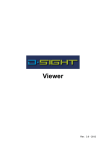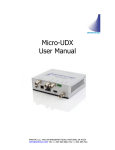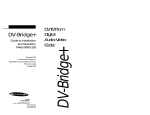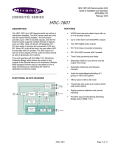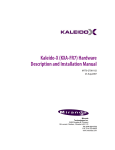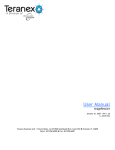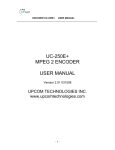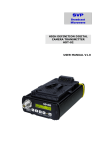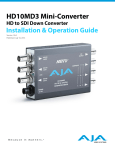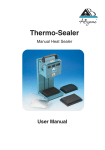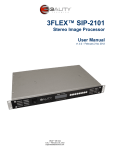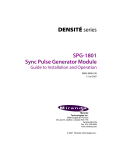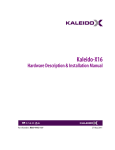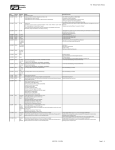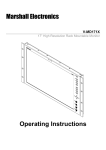Download DVC-800 Downconverter and DV Encoder for HD
Transcript
DVC-800 Guide to Installation and Operation Downconverter and DV Encoder for HD Acquisition M619-9900-100 Miranda Technologies inc. 3499 Douglas-B.-Floreani St-Laurent, Québec, Canada H4S 1Y6 Tel. 514-333-1772 Fax. 514-333-9828 www.miranda.com DVC-800 Copyright 2003 Miranda Technologies Inc. Specifications may be subject to change. Printed in Canada March 2003 GUIDE TO INSTALLATION AND OPERATION Warranty Policies Warranty Statement Miranda Technologies Inc. warrants that the equipment it manufactures shall be free from defects in material and workmanship for a period of two (2) years from the date of shipment from the factory. If equipment fails due to such defects, Miranda Technologies Inc. will, at its option, repair or provide a replacement for the defective part or product. Equipment that fails after the warranty period, has been operated or installed in a manner other than that specified by Miranda, or has been subjected to abuse or modification, will be repaired for time and material charges at the Buyer’s expense. All out-of-warranty repairs are warranted for a period of ninety (90) days from the date of shipment from the factory. Miranda Technologies Inc. makes no other warranties, expressed or implied, of merchantability, fitness for a particular purpose or otherwise. Miranda’s liability for any cause, including breach of contract, breach of warranty, or negligence, with respect to products sold by it, is limited to repair or replacement by Miranda, at its sole discretion. In no event shall Miranda Technologies Inc. be liable for any incidental or consequential damages, including loss of profits. Effective January 1, 2002 Warranty Exchange Policies Miranda Technologies Inc. warrants that the equipment it manufactures shall be free from defects in materials and workmanship for a period of two (2) years from the date of shipment from the factory. If equipment fails due to such defects, Miranda will provide repair of the failed unit under the terms of the Miranda warranty. If the equipment has been proven to be defective on arrival, Miranda will ship a new product in exchange, usually within 36 hours of factory notification. If the equipment to be repaired is essential and the customer so requests, Miranda will, at its option, provide a service replacement or loaner part or product, usually within 36 hours of factory notification, weekends and holidays excluded. All warranty exchange or loaner parts or products shall be shipped to the Buyer with a packing list clearly describing the items and stating the date of shipment. Repaired parts or products will be shipped to the Buyer with a similar packing list. In the case of exchange, the defective products or parts must be returned to Miranda within fifteen (15) days from receipt by the customer of the exchange product. In the case of a loaner, the loaned products or parts must be returned to Miranda within fifteen (15) days from receipt by the customer of the repaired equipment. If the equipment is not returned within fifteen (15) days, as described for either exchanges or loans, A Rental Invoice will be generated. Rental terms will be fifteen (15) percent of the current list price of the products or parts per month or a fraction thereof. Before returning the equipment to Miranda Technologies Inc., for any reason, the Buyer must first obtain a Return Authorization Number from Miranda Technologies Inc. Miranda Technologies Inc will pay freight and insurance charges for the delivery of the loaner or exchange products or parts. Freight and insurance charges for the return of the defective product or part will also be paid by Miranda Technologies. Out-Of-Warranty Repair Policy Miranda will service out-of-warranty repairs using the following model: Miranda will charge 15% of the current list price of the product, with a minimum charge of $150. Products whose list price is under $150 will be replaced at a charge equal to current list prices. In the case of obsolete products, the last published list price for the products will apply. In the case of a product deemed beyond repair, the customer must purchase a new product at current retail prices. All out-of-warranty repairs are warranted for a period of 90 days from the date of shipment from the factory. Before returning the equipment to Miranda Technologies Inc., for any reason, the Buyer must first obtain a Return Authorization Number from Miranda Technologies Inc. The Buyer will pay freight and insurance charges for the return of the defective product or part to the manufacturer for repair. Miranda Technologies will pay freight and insurance charges for the return of the repaired product or part to the Buyer. Out-Of Warranty Equipment Updates and Spare Parts Policy Miranda Technologies will charge cost plus 20% of the parts costs and $40.00 shipping and handling for out-of-warranty equipment updates, or the sales of spare parts. DVC-800 | i GUIDE TO INSTALLATION AND OPERATION Safety Compliance Information Safety Compliance This equipment complies with: - CAN/CSA C22.2 No. 950-95 / Safety of Information Technology Equipment, Including Electrical Business Equipment. UL Std. No. 1950, 3rd Ed. / Safety of Information Technology Equipment, Including Electrical Business Equipment. EN 60950:1992 (2nd edition) Incorporating A1, A2, A3, A4, and A11/ Safety of Information Technology Equipment, Including Electrical Business Equipment. CAUTION These servicing instructions are for use by qualified service personnel only. To reduce the risk of electric shock, do not perform any servicing other than that contained in the operating instructions unless you are qualified to do so. Refer all servicing to qualified service personnel. Servicing should be done in a static-free environment. Electromagnetic Compatibility - This equipment has been tested for verification of compliance with FCC Part 15, Subpart B, class A requirements for Digital Devices. This equipment complies with the requirements of: EN 55022 Class A, Electromagnetic Emissions, EN 61000-3-2 & -3-3, Disturbance in Supply Systems EN 61000-4-2, -3, -4, -5, -6, -8 & -11 Electromagnetic Immunity How to contact us: Head Office Miranda Europe Miranda Asia Miranda Technologies Inc. 3499 Douglas-B.-Floreani St. Laurent (Montreal), Que. H4S 1Y6 Canada 222, 226 Rue De Rosny 93100 Montreuil France Mita Nexus Bldg. 2F 1-3-33 Mita, Minato-Ku Tokyo, Japan 108-0073 Tel Fax Toll free: +33 1 55 86 87 88 +33 1 55 86 00 29 +81 3 5730 2988 +81 3 5730 2973 +1 (514) 333-1772 +1 (514) 333-6914 1-800-224-9828 www.miranda.com ii | DVC-800 GUIDE TO INSTALLATION AND OPERATION Table of Contents 1 DVC-800 Downconverter and DV Encoder for HD Acquisition ................................. 1 1.1 Introduction .............................................................................................................................................. 1 1.2 Features ................................................................................................................................................... 2 2 Installation ..................................................................................................................... 4 2.1 Unpacking ................................................................................................................................................ 4 2.2 Mechanical Installation............................................................................................................................. 4 2.3 Electrical Installation ................................................................................................................................ 5 2.3.1 Camera and Battery connectors........................................................................................................ 5 2.3.2 Inputs and Outputs ............................................................................................................................ 5 2.3.3 Serial Communication Connector (RS-232) Layout .......................................................................... 6 2.3.4 Analog audio Connector Layout ........................................................................................................ 6 3 Configuration ................................................................................................................ 7 3.1 Large-scale production ............................................................................................................................ 7 3.2 Stand-alone Operation............................................................................................................................. 7 4 Operation ....................................................................................................................... 8 4.1 Powering Up............................................................................................................................................. 8 4.2 Local User Controls ................................................................................................................................. 8 4.2.1 POWER ............................................................................................................................................. 8 4.2.2 SAFETY ZONE.................................................................................................................................. 8 4.2.3 MARKERS......................................................................................................................................... 8 4.2.4 CENTER MARK ................................................................................................................................ 8 4.2.5 STATUS LEDS .................................................................................................................................. 8 4.2.6 Dip Switches...................................................................................................................................... 9 4.3 Supported HD Video Frame Rates .......................................................................................................... 9 4.4 Video Operation ..................................................................................................................................... 10 4.4.1 Video Source Selection ................................................................................................................... 10 4.4.2 Markers............................................................................................................................................ 10 4.4.3 Using the Aspect-Ratio Converter................................................................................................... 10 4.4.4 On-Screen Display (OSD) Configuration ........................................................................................ 12 4.4.5 Frame rate conversion from 23.98sF to 29.97 ................................................................................ 12 4.4.6 DV Operation & External Device Control ........................................................................................ 13 4.5 Audio Operation ..................................................................................................................................... 13 4.6 Time Code Operation............................................................................................................................. 15 4.6.1 Time Code source selection............................................................................................................ 15 4.6.2 User Bits .......................................................................................................................................... 16 4.7 Metadata and Telemetry ........................................................................................................................ 16 4.7.1 Telemetry Mode............................................................................................................................... 16 4.7.2 Control Mode ................................................................................................................................... 16 5 Specifications...............................................................................................................17 5.1 Input Specifications................................................................................................................................ 17 5.2 Output Specifications ............................................................................................................................. 17 5.3 Power Specifications.............................................................................................................................. 18 5.4 Processing Performance........................................................................................................................ 18 5.4.1 Video ............................................................................................................................................... 18 5.4.2 Audio ............................................................................................................................................... 18 5.4.3 Time Code ....................................................................................................................................... 19 DVC-800 | iii GUIDE TO INSTALLATION AND OPERATION iv | DVC-800 GUIDE TO INSTALLATION AND OPERATION 1 DVC-800 Downconverter and DV Encoder for HD Acquisition 1.1 Introduction The DVC-800 is the latest in camera-adapted conversion devices from Miranda and was designed to enhance electronic acquisition of material using HD cameras such as the SONY HDCAM (DVC-800) or Panasonic Varicam (DVC-820). The DVC provides a unique combination of outputs and functionality to facilitate monitoring, review and approval, rough cut editing and the preparation of dailies while on set. Designed in cooperation with a number of electronic acquisition pioneers, the DVC is the indispensable tool for electronic acquisition. The SD video signal output allows the use of inexpensive monitors instead of costly high definition monitors. The DVC-800 provides a built-in aspect-ratio converter allowing 16:9 images to be displayed on 4:3 monitors. The built-in 4:3 and 16:9 graticule generator allows on-screen display of aspect ratio markers. Also, the OSD (On-Screen Display) unit allows information such as time code and scene numbers to be directly seen on the screen on any down-converted outputs. The DVC-800 also does conversion from DV to composite and SD SDI. The DVC-800’s low power consumption and miniature package make it ideal for onsite applications. HD Cam AES 2 AES 1 TC HD SDI IN HD Digital // Camera Audio HD SDI Audio/TC Mux + // to Serial HD SDI 10-bit SD Cam SD DV AES 2 AES 1 TC Down Scaler and ARC // HD SD Cam SD DV AES 1 Ch-1/2 AES 2 Ch 3/4 Audio/TC Mux + // to Serial SDI 10-bit Composite Encoder + D to A Composite Y 8-bit Video LTC Cam TC Audio TC Graticule, Burn In TC, OSD Audio TC SD Play SD Cam Cam TC Audio TC AES 2 Ch 3/4 SD TC In AES In DV CODEC Analog Audio Out DAC DV from/to IEEE-1394 Formatter IEEE-1394 AES Out uControler DC IN Belt POWER DC IN Battery Pack PDA Ctl, GPI, Telemetry DC Out To Camera Figure 1 – Block Diagram DVC-800 | 1 GUIDE TO INSTALLATION AND OPERATION 1.2 Features Video Input ¾ One (1) HD SDI input ¾ Extraction of embedded audio group 1 ¾ Extraction of ATC (video time code) ¾ One (1) SONY HDCAM Parallel video input with audio ¾ Channel 1/2 audio input from camera ¾ Channel 3/4 audio output to camera ¾ Pseudo-Automatic frame rate detection of HD video input ¾ Down-converted HD Formats: 1920x1080i/59.94 1920x1080p/29.97sF 1920x1080i/50 1920x1080p/25sF 1920x1080p/23.98sF 1280x720p/59.94 1280x720p/50 ¾ Pass-through mode formats (to HD SDI out only) 1920x1080i/60 1920x1080p/30sF 1920x1080p/24sF 720p/60 ¾ Automatic or Manual selection between HD SDI or HDCAM SONY video input Video Output ¾ Two (2) HD SDI outputs including: ¾ Four (4) embedded audio channels ¾ ATC video time code (line 10) ¾ One (1) down-converted 10-bit SDI output including: ¾ 4 embedded audio channels ¾ DVITC (lines 14/16 and 277/279 in 525, lines 19/21 and 332/334 in 625) ¾ Graticule markers (selectable ON/OFF) ¾ Burned-in information such as time codes (Selectable ON/OFF) ¾ Down-converted 525/625 DV output via IEEE-1394 including: ¾ Two 16-bit audio channels (48KHz) selectable between channels 1/2 and 3/4 ¾ Video and audio time codes ¾ Telemetry and metadata related to the scenes annotations ¾ Burned-in information such as time codes (Selectable ON/OFF) ¾ Down-converted composite (NTSC/PAL) and luminance (Y) output ¾ VITC insertion (lines 14/16 and 277/279 in 525, lines 19/21 and 332/334 in 625) ¾ Burned-in information such as time codes (Selectable ON/OFF) ¾ Graticule markers ¾ Aspect-ratio conversion allows: ¾ Display of 16:9 camera output on 4:3 (letterbox) or 16:9 monitors ¾ Predefined settings for resizing/cropping video in 4:3, 13:9, and 14:9 aspect ratio ¾ Selectable Graticule markers (for SD SDI, Composite/Y only): ¾ Safety zone markers for 4:3, 13:9, 14:9 selectable 50% transparent, line or opaque ¾ Safe title (80%), safe area (90%), 92.5%, 95%, 90% of 4:3 ¾ One (1) user-programmable marker ¾ Two (2) types of center cross General ¾ One RS-232 port, selectable for telemetry or control ¾ Analog audio output for monitoring channels 1/2 or 3/4 ¾ Battery Pack style, attached directly to the camera ¾ Optimized power consumption - only the circuits in use are powered ¾ Auto Power Off ¾ DV power management ¾ DV sequence playback to SDI and Composite/Y ¾ Automatic detection of 525/625 2 | DVC-800 GUIDE TO INSTALLATION AND OPERATION ¾ ¾ DV/DVCPRO1 compatible Burned-in metadata information Special ¾ Frame rate conversion from 23.98sF to 59.94i using conventional 3:2 pull-down sequence ¾ White line insertion (line 12) on Composite/Y and SDI output for flagging 1st frame of the sequence ¾ Time code processing from 24f/s to 30f/s (non-drop frame only) ¾ External DV Device Control capabilities (AV/C protocol) ¾ Audio LTC input ¾ Replaces channel 4 of the embedded audio when present ¾ Can be inserted in DV as metadata ¾ Distinct graticule markers settings in DV playback mode and in normal mode ¾ Default configuration settings: for burned-in information and the user marker 1 Locked audio not supported for DVCPRO DVC-800 | 3 GUIDE TO INSTALLATION AND OPERATION 2 Installation 2.1 Unpacking Make sure the following items have been shipped with your DVC-800. If any of the following items are missing, contact your distributor or Miranda Technologies Inc. • • DVC-800 Downconverter and DV encoder for HD Acquisition This manual 2.2 Mechanical Installation The DVC-800 is installed at the rear of the camera body, positioned between the camera and the external battery, and incorporates connectors and hardware which allow it to attach and connect to these two components. The DVC-800 is designed to work with Sony HD cameras, and a variety of batteries, e.g. IDX, Anton Bauer or PAG. These batteries have different mechanical interfaces, so it is necessary to specify the battery type when ordering your DVC-800. Figure 1.1 Mechanical installation of the DVC-800 To install the DVC-800 on the Sony HDCAM: • remove the external battery or any other attachments on the rear of the camera body • remove the small cap protecting the camera connector by removing the attaching screw. • position the DVC-800, and push in and down until the HD CAM connector on the camera body mates with the connector on the DVC-800 • tighten the two screw fasteners on the upper bracket to secure the DVC-800 in position • Re-install the external battery or other attachment onto the rear of the DVC-800 case 4 | DVC-800 GUIDE TO INSTALLATION AND OPERATION 2.3 Electrical Installation 2.3.1 Camera and Battery connectors The Sony HDCAM connector is integral to the mounting bracket, and connection is made when the DVC-800 is mounted on the rear of the camera body. As well, the external DC input is passed through the DVC-800. 2.3.2 Inputs and Outputs All remaining input and output connectors are located on the side of the DVC-800 body. The figure shows the location of the various connectors. DIP switches LTC in HD SDI in AUDIO LTC in HD SDI out 1 COMPOSITE out HD SDI out 2 Y out SDI out RS-232 ANALOG AUDIO out External DC in AES in DV in/out (IEEE-1394) Figure 1.2 Location of connectors on the DVC-800 DVC-800 | 5 GUIDE TO INSTALLATION AND OPERATION 2.3.3 Serial Communication Connector (RS-232) Layout 1 2 6 3 7 4 8 1 = NC 2 = (Rx) Receive (Input) 3 = (Tx) Transmit (output) 4 = 3.3VDC* 5 = Ground 6 = NC 7 = 3.3VDC* 8 = NC 9 = Force HD SDI input 5 9 * WARNING The 3.3VDC pins should be used with caution.They are meant to power external devices drawing less than 2mA. Do not short to ground. Any misuse may cause permanent damage to the unit To force the HD SDI input at all times, short pin 9 to pin 5 (ground). See the discussion on video source selection in Section 4.4.1 2.3.4 Analog audio Connector Layout 6 1 45 2 4 6 | DVC-800 3 1 = Ground 2 = Reserved 3 = Reserved 4 = Ground 5 = Audio Out Right 6 = Audio Out Left GUIDE TO INSTALLATION AND OPERATION 3 Configuration 3.1 Large-scale production The figure below illustrates a production configuration involving all of the inputs and outputs available on the DVC-800. Observe how master recordings, dailies, on-set monitoring and off-line post-production capabilities are all supported and facilitated through the use of the DVC-800. Subsets of this configuration may be appropriate for less complex production situations. Figure 3.1 DVC-800 at the center of a studio production 3.2 Stand-alone Operation DV Drive One useful application for the DVC-800 involves the use of a DV recorder installed between the DVC-800 and the battery, as shown in figure 3.2. This recorder, supplied with DV video and time code through the IEEE-1394 feed, records a low-definition copy of the master recording which is being recorded on the camera’s HD cassette. This can be used immediately for off-line post production or dailies, eliminating the need for dubbing after production is completed. Figure 3.2 Stand-alone operation of the DVC-800 DVC-800 | 7 GUIDE TO INSTALLATION AND OPERATION 4 Operation 4.1 Powering Up Use the Power button (section 4.2.1) to toggle between: 1. ON (ON LED is lit) 2. AUTO OFF (both LEDs are lit) If there is no Input signal for more than 30 seconds, the unit will turn off 3. OFF (both LEDs are off) The unit is OFF (Note: no power is consumed when the unit is OFF) Use the dip switches HD OUT and SD OUT (see section 4.2.6) to control the power to the indicated output. 4.2 Local User Controls The side panel incorporates 4 pushbuttons and 14 LEDs grouped into 5 sections (see fig.4.1): 4.2.1 POWER (discussion in section 4.1) Pushbutton: LEDs (2): Power mode cycles through ON, AUTO OFF, and OFF ON Illuminated in ON and AUTO OFF modes AUTO OFF Illuminated in AUTO OFF mode (turns unit OFF if there is no input signal for more than 30 seconds) 4.2.2 SAFETY ZONE Pushbutton: Selects between OFF, 80%, 90%, 92.5%, 95%, 4:3 LEDs (4): 80%, 90%, 92.5%, 95% (both 80% and 90% illuminate to indicate 4:3 mode) 4.2.3 MARKERS (discussion in section 4.4.2) Pushbutton: Selects between OFF, 4/3, 13/9, 14/9, FILM LEDs (3): 4/3, 13/9, 14/9 (both 4:3 and 13:9 illuminate to indicate FILM mode) 4.2.4 CENTER MARK Pushbutton: Cycles between ON (normal cross), ON (small cross) and OFF LED: Illuminates when Centre Mark is turned ON (either size) ON Note: Two different sets of settings for the markers are stored in the DVC-800 - one for the down-converter mode, and one for the DV playback mode. These settings are memorised and retained when the unit is turned off. 4.2.5 STATUS LEDS LEDs (4): HD IN PRESENCE GREEN: HD signal detected at the input [POWER STATUS} HD OUT SD OUT DV 8 | DVC-800 GREEN: HD-SDI output is active GREEN: SD outputs (SDI and analog) are active GREEN: A device is connected to the Firewire plug and powered on. Figure 4.1 GUIDE TO INSTALLATION AND OPERATION 4.2.6 Dip Switches There are 16 dip-switches located on the upper side panel of the DVC-800, laid out as shown in the figure below. OSD 24/30/60 i LINE BLACK ON ON ON ON DISPLAY: 4/3 DEF. STD:525 FORMAT: DV AUDIO: CAM CTRL: OFF RS-232: CTRL HD OUT: OFF SD OUT: OFF DV FR: 23.98/29.97/59.94 PsF FORMAT: MARKERS: MASK 50% MASK: SDI MARKERS: OFF SDI: OFF COMP/Y: OFF OFF DV: 16/9 625 DVCPRO25 AES ON TELEMETRY ON POWER ON MGNT Figure 4.2 DIP-switch layout The functionality of these switches is as follows: FR (frame rate) FORMAT MARKERS MASK SDI MARKERS OSD SDI OSD COMP/Y OSD DV DISPLAY DV DEF. STD DV FORMAT DV AUDIO DV CTRL RS232 POWER MGNT HD OUT SD OUT Selects between 60/30/24 or 59.94/29.97/23.98 for HD standard detection Selects between PsF or i for HD standard detection Selects between Mask or Line for the markers (See section 4.4.2) Selects between 50% transparent or Black. (See section 4.4.2) Toggles the markers ON/OFF for the SD SDI output Selects between ON or OFF for OSD on SDI output Selects between ON or OFF for OSD on composite and Y output Selects between ON or OFF for OSD on DV output Selects between 4/3 or 16/9 monitors (See section 4.4.2) Selects between 525 or 625 for DV default standard Selects between DV or DVCPRO25 compression Selects the audio to record in DV among the 4 available audio channels CAM = Camera audio (either from HD SDI or form SONY connector) AES = From the AES input Enable/Disable the DV device control option (See section 4.4.6) Selects between Telemetry or Control (See section 4.7) (see section 4.1) Selects between AUTO or OFF for power on the HD SDI output Selects between AUTO or OFF for power on composite, Y and SDI outputs 4.3 Supported HD Video Frame Rates NDF DF NDF 59.94i DF 50i NDF 30PsF DF NDF 29.97PsF DF 25PsF 24PsF 23.98PsF - CAMERA FORMAT 60i SDI/DV/CVBS/Y 29.97Hz n/a n/a OK OK n/a n/a n/a OK OK n/a n/a 3:2 Pull Down Time Code n/a n/a 30 f/s NDF 30 f/s DF n/a n/a n/a 30 f/s NDF 30 f/s DF n/a n/a 30 f/s NDF DVC-800 OUTPUT SDI/DV/CVBS/Y 25Hz n/a n/a n/a n/a OK n/a n/a n/a n/a OK n/a n/a Time Code n/a n/a n/a n/a 25 f/s n/a n/a n/a n/a 25 f/s n/a n/a HD SDI 60i 59.94i 50i 30PsF 29.97PsF 25PsF 24PsF 23.98PsF Table 4.1 – Supported HD Video Frame Rates DVC-800 | 9 GUIDE TO INSTALLATION AND OPERATION 4.4 Video Operation 4.4.1 Video Source Selection If DV is input to the DVC-800 on the IEEE1394 connector, it is by default converted and sent to the SD video outputs (composite,Y,SDI). When there is no DV input to the DVC-800, the output is derived from one of the two HD inputs, selected according to the following priorities: - If a signal is present on the HDCAM connector, it is selected - If no signal is present on the HDCAM connector, the HD SDI input is selected - The user can short a pin on the RS-232 connector to force the HD SDI input to be selected (see section 2.3.3 for details) The input video format is detected automatically within groups which are selected by the user using the Frame Rate dip-switch and the i/PsF dip-switch. Here is a table of the supported formats and the state of those switches for each case. 4.4.2 Markers HD Format 1080i59.94 1080i50 720p50 720p59.94 1080p29.97sF 1080p23.98sF 1080p25sF 720p60 1080i60 1080p30sF 1080p24sF Dip switch state FR. RATE: 23/29/59 FORMAT: PsF 24/30/60 i FR. RATE: 23/29/59 FORMAT: PsF 24/30/60 i FR. RATE: 23/29/59 FORMAT: PsF 24/30/60 i FR. RATE: 23/29/59 FORMAT: PsF 24/30/60 i Table 4.2 dip-switch settings for video source selection There exist multiple configurations for the markers. They are configured using the dip switches and the buttons on the DVC-800 case. Figure 4.3 on the next page shows each configuration and its corresponding dip switch position. Note that there is no black mask in 4:3 display mode. Instead the screen is scaled to fit the selected aspect ratio. This mode activates the aspect-ratio converter (ARC). The markers are always visible on the Composite/Y outputs. They can be set to ON or OFF on the SD SDI output. They are never present on the DV output. The FILM marker is use-programmable via software. The factory default is 1.85:1 aspect ratio. 4.4.3 Using the Aspect-Ratio Converter The aspect-ratio converter (ARC) can be enabled only with 4:3 monitors. To activate the ARC: Set the dip switch DISPLAY to the position 4/3 Set the dip switch MARKERS to the position Mask. Set the dip switch MASK to the position Black. Use the Markers button on the control panel to choose the aspect-ratio The result is shown on the right-hand column of figure 4.3. The ARC affects all down-converted outputs. 10 | DVC-800 GUIDE TO INSTALLATION AND OPERATION Figure 4.3 Marker configurations DVC-800 | 11 GUIDE TO INSTALLATION AND OPERATION 4.4.4 On-Screen Display (OSD) Configuration It is possible to display the following elements on the screen: Main Title Scene Description Episode Number Scene Number Shot Number Take Number Reel Number Director's name Cameraman's name Camera Number Lens description Location Circled take UMID 32 Bytes Binary Producer's name 10 User-defined fields HD TC Position Rec Video TC Position Rec Audio TC Position HD Video Format Start Time Title TC Position Recorded Date The OSD screen can display 12 lines of 28 characters. The user-defined fields allow the display of almost anything on the screen. The configuration of the OSD can be accomplished using software available on Miranda’s web site. Software is available for both PC and PDA platforms. For more information on how to configure the OSD, see section 4.7.2. The OSD can be turned ON and OFF independently on the SDI, COMPOSITE/Y and DV outputs. Select the desired status using the three OSD dip-switches. 4.4.5 Frame rate conversion from 23.98sF to 29.97 When 23.98sF HD formats are input to the DVC-800, a frame rate conversion is done automatically. The process involves a conventional 3:2 pull-down sequence. The DVC-800 uses the video time code to synchronize the sequence. The pull-down sequence, and the resulting frame correspondence over a period of 1 second are shown in figure 4.4. 1080p23.98sF :00 A1 525i :01 A2 A1 A2 :00 B1 :02 B2 B1 B2 :01 C1 :03 C2 B1 C2 :02 D1 C1 D2 :03 D2 D1 D2 :04 1 second 24fps 30fps :00 :01 :02 :03 :04 :05 :06 :07 :08 :09 :10 :11 :12 :13 :14 :15 :16 :17 :18 :19 :20 :21 :22 :23 :00 :01 :02 :03 :04 :05 :06 :07 :08 :09 :10 :11 :12 :13 :14 :15 :16 :17 :18 :19 :20 :21 :22 :23 :24 :25 :26 :27 :28 :29 Figure 4.4 Frame-rate conversion using 3:2 pull-down 12 | DVC-800 GUIDE TO INSTALLATION AND OPERATION 4.4.6 DV Operation & External Device Control The DVC-800 is able to encode or decode DV25 and DVCPRO252 video formats in 525-line or 625-line format (corresponding to the video input signal). In the normal state when there is no incoming DV stream, the DVC-800 encodes a DV stream from the HD downconverted video input to the DV port. When an external DV stream is detected, the DVC-800 decodes this video stream and displays it through the other SD outputs. The DVC-800 can control one external DV device3 (through the DV port) if it has VTR (video tape recorder) capabilities (e.g. the AV/C protocol). We don't recommend connecting more than one DV device (of the VTR type4) to the DVC-800 because, if there is more than one, there is no way to select which one will be controlled. Device control works as follows: • The DVC-800 searches for an external DV device that supports VTR commands. • If it finds one, it polls the VTR stable state (stop, pause/still or record pause)5. • When a running timecode starts at the LTC input (LTC in), the DVC-800 sends a record command to the external VTR. • If the timecode stops or there is a discontinuity in the timecode sequence, the DVC-800 sends a command corresponding to the previous stable state. So, the user must set the VTR to the desired stable state before connecting it to the DVC-800, and ensure that there is no running timecode at the LTC input when the device is connected. 4.5 Audio Operation Figure 4.5 on the next page illustrates the audio processing functions of the DVC-800. Audio Inputs: - Sony camera - HD SDI in (embedded audio) - AES external - Audio LTC in - DV Audio Outputs: - Embedded in HD - Embedded in SD - Audio 3-4 to camera - Analog audio out - DV Audio follows the same priorities as video; that is, if a DV input is present, it takes priority over the HD input, and the audio from the DV input will appear on the analog and SD outputs. In the HD->DV mode, audio will be embedded in this order of priority: Audio LTC in, AES in, HD SDI in or Sony audio. Description of inputs and outputs : HD CAM Sony: The HD CAM connector is proprietary to Sony, and is located at the rear of their cameras. There is always an audio signal, either voice, tone or mute. Audio 3 and 4 from the external AES IN of the DVC-800 is always routed to the camera through this connector. 2 Locked audio is not supported for the DVCPRO25 format. This can be a problem for some DVCPRO VTRs that will not accept the DVCPRO stream from the DVC-800. To be able to record the DVCPRO stream on a DVCPRO VTR, the user might have to select a different audio source than the one included in the stream. 3 By "DV device" we mean a camcorder, a VTR, a firewire hard drive with device control capabilities (e.g. the AV/C protocol) but not a computer. A computer is a general firewire device and not specifically a DV device. 4 A DV device of the VTR type can be a real VTR, a camcorder set in VTR mode, a hard drive with DV VTR capabilities or a device of the DV-Bridge series (or any other DV transcoders with device control capabilities). 5 No other state is supported. DVC-800 | 13 GUIDE TO INSTALLATION AND OPERATION HD SDI IN: The audio found in group 1 of the HD VIDEO IN is disembedded. If there is no external AES IN or AUDIO LTC (time code) IN, this audio is completely reconstituted at the output. The group 1 audio is extracted for the other outputs in any case.. AES IN: This audio is input through the XLR AES IN connector, also referred to as external AES. This source will be embedded in AES2, and will be sent to the DV and analog outputs when the dip switch is in the AES position. Audio LTC in: When audio time code is present, it will be embedded in channel 4, i.e. the right channel of AES2. Embedded HD: When both external AES audio and LTC time code are absent, the audio from the HD source is present at this output in its entirety. When external AES audio is present, the camera audio will be found on AES1, while the external AES audio will appear in AES2. Embedded SD: Only the first group is embedded. In the HD->SD mode, AES1 comes from either the camera or from the audio embedded in the HD SDI IN. AES 2 could come from the audio embedded in the HD SDI IN, from the external AES IN or from the AUDIO LTC IN. In the DV->SD mode, AES1 is sourced from the DV, while AES2 comes from the external AES IN or from the AUDIO LTC IN Audio 3-4: The audio which is sent to the camera, audio 3/4, always comes from the external AES input. Analog: The analog audio output is identical to the audio sent to the DV output; it originates from the DV input in the DV->SD mode. DV: Source of audio in the DV-> SD mode, receiver of audio in the HD-> DV mode. Choose between AES1 and AES2 with the CAM/AES dip-switch, where CAM=AES1 and AES=AES2. Note that the internal sampling rate is always 48KHz because of the sample rate converters. DV audio is 16 bits, whereas the HD and SD audio is 24 bits. While in playback use the DV source. DV_AES1 HD cam Sony Audio Sony Sony_AES1 1-2 AUDIO34 Emb_AES1 1-2 * * AES1 HD EMB. IF DV-> SD no output HD SD EMB. HD SDI IN Audio Emb HD SDI Emb_AES2 DV, analogue 3-4 3-4 AES IN AES externe Aes externe 3-4 3 AES2 * CAM (1-2) = AES1 AES (3-4) = AES2 4 AUDIO LTC IN Time code audio Audio LTC 4 * 4 4 Figure 4.5 Audio processing in the DVC-800 14 | DVC-800 Dip Switch GUIDE TO INSTALLATION AND OPERATION Audio Operation Sony 1 CAM √ √ √ √ HD SDI √ √ √ √ Video Video Video Video √ 1 2 3 Input AES IN AUDIO LTC IN DV IN √ √ √ √ √ √ √ √ √ √ √ √ √ √ √ √ √ √ Internal AES1 AES2 Sony Sony Sony DV HD SDI HD SDI HD SDI DV ------------DV ----AES in AES+TC ----HD SDI AES in AES+TC --------AES in AES+TC ----- EMB HD Aes1 Aes1+2 Aes1+2 ----2 Audio Aes1+2 Aes1+2 --------Aes2 Aes2 ----- EMB SD Aes1 Aes1+2 Aes1+2 Aes1 Aes1+2 Aes1+2 Aes1+2 Aes1 ----Aes2 Aes2 Aes1 Output Audio 3-4 ----AES in AES in AES in ----AES in AES in AES in ----AES in AES in AES in Analog & DV OUT 3 CAM AES Sony ----Sony AES in Sony AES+TC DV DV HD SDI HD SDI HD SDI AES in HD SDI AES+TC DV DV ------------AES in ----AES+TC DV DV = Audio present = There is always audio coming from the SONY HDCAM. = Passthrough audio only = Dip switch (audio DV) 4.6 Time Code Operation The DVC-800 integrates many different time codes: Title Time Code: Video HD time code : Video SD time code: Audio time code: In DV playback only. Time code generated by DV applications Original time code synchronized with the HD video input Processed time code synchronized with the SD video output Audio time code sampled at SD frame rate Any of these time codes can be displayed on the screen. 4.6.1 Time Code source selection There are 3 possible sources of video time code and one source of audio time code: Video time code sources: Audio time code source: External LTC, External from HD SDI input, Internally generated External LTC only Video time code source selection: • When all time code sources are present, the LTC input has priority over the others. Therefore, the DVC800 will not read the time code embedded in the HD SDI input signal if an external LTC signal is present. • When no time code source is present, the DVC-800 generates its own time code. This is necessary for DV to work properly and also for the frame rate converter. Audio time code source selection: • If a signal is present at the Audio LTC input, the time code is extracted and re-sampled at the SD frame rate. This is necessary since the audio LTC has to follow the video path. • If no signal is present, no internal time code is generated and its value remains unchanged In some cases, the time code is processed and compensated for delays. In other cases, no compensations are required. See section 5.4.3 for time code processing performance. DVC-800 | 15 GUIDE TO INSTALLATION AND OPERATION 4.6.2 User Bits User bits are part of the time code. They are transported along with the time code. No modifications are performed on them. In some cases, the user bits are delayed with respect to the picture. See section 5.4.3 for information on delays. 4.7 Metadata and Telemetry Metadata (for the DVC-800) is data that carries information about the video image such as time, date, scene number, etc. This data is directly inserted into the DV signal. It can be extracted from the resulting DV file during post-production and used to select desired scenes. Metadata is a powerful tool for video editing. The DVC-800 can insert and extract metadata is two different ways: • • Telemetry Mode: Everything (every character) received via the asynchronous port (RS-232) is inserted in metadata. Control Mode: Use this mode to configure the OSD and at the same time the information that will be inserted as metadata. This mode should be selected in order to use the configuring software. The user can select the operating mode using the CTRL/TELEMETRY dip switch. In all cases, the information to be inserted as metadata is sent via the RS-232 connector, and the DVC-800 must connected to a PC or a PDA. 4.7.1 Telemetry Mode In Telemetry Mode, all data arriving at the RS-232 port is packaged and inserted as metadata into the DV signal. Miranda does not specify the data format, so this mode is suitable for third-party devices using proprietary formats for specialized applications which involve the transfer of metadata into postproduction. As an example, this mode could be used to transfer camera positioning and movement data for integrating camera video into graphical environments. 4.7.2 Control Mode In Control Mode, the RS-232 port is connected to a PC or PDA running software created by Miranda. This software allows the user to perform two functions: • • Specify the metadata which is to be included in the DV datastream. A list of standard items representing the most-frequently used information is pre-defined, but there are also ten user-defined items which can include any other data which is available. Specify which of this metadata will be shown in the On Screen Display (OSD) and how and when it will appear. The functionality of this software is fully explained in its User Manual. 16 | DVC-800 GUIDE TO INSTALLATION AND OPERATION 5 Specifications 5.1 Input Specifications HD SIGNAL FORMAT CONNECTOR 20-bit Y-Pb-Pr HD as per HDW-F900 Sony Interface 1920x1080i/59.94 SMPTE-274M 1920x1080i/60 SMPTE-274M 1920x1080p/30sF SMPTE-274M 1920x1080p/29.97sF SMPTE-274M 1920x1080i/50 SMPTE-274M 1920x1080p/25sF SMPTE-295M 1920x1080p/24sF SMPTE-274M 1920x1080p/23.98sF SMPTE-274M 1280x720p/59.94 SMPTE-296M 1280x720p/50 SMPTE-296M 1280x720p/60 SMPTE-296M 50-pin camera connector, as per Sony HDW-F900 HD SDI SIGNAL RETURN LOSS CONNECTOR 4:2:2 SMPTE 292M, SMPTE 299M > 15 dB up to 1.5 GHz 75 Ω BNC AUDIO CAM (1/2) LEVEL: CONNECTOR per Sony HDW-F900 LVTTL, 3.3V 50-pin camera connector, as per Sony HDW-F900 AES2 (3/4) SIGNAL LEVEL: IMPEDANCE: CONNECTOR AES3 0.2 to 7.0 Vp-p 110 Ω balanced XLR-3F LTC SIGNAL LEVEL: CONNECTOR SMPTE 12M 0.2 to 5 Vp-p 75 Ω BNC 5.2 Output Specifications HD SDI SIGNAL RETURN LOSS JITTER CONNECTOR 4:2:2 SMPTE 292M, SMPTE 299M > 15 dB up to 1.5 GHz < 0.2 UI p-p 75 Ω BNC SDI SIGNAL RETURN LOSS JITTER CONNECTOR 4:2:2 SMPTE 259M, SMPTE 272M > 15 dB up to 270 MHz < 0.2 UI p-p 75 Ω BNC COMPOSITE SIGNAL NTSC (525/60) SMPTE 170M PAL (625/50) ITU RT 470 > 20 dB up to 5.75 MHz < -58 dB to 5.75 MHz (unweighted) 75 Ω BNC RETURN LOSS SNR CONNECTOR DVC-800 | 17 GUIDE TO INSTALLATION AND OPERATION Y SIGNAL RETURN LOSS: SNR CONNECTOR: Luminance only (525/60 or 625/50) > 20 dB up to 5.75 MHz < -58 dB to 5.75 MHz 75 Ω BNC DV SIGNAL CONNECTOR DV/DVCPRO25 on IEEE-1394a IEEE-1394 6 pin AUDIO SIGNAL LEVEL: IMPEDANCE SNR CONNECTOR Stereo unbalanced line out 1.0 Vp-p < 600 Ω < 70 dB Ref 0 dBFS (A weighted) Mini XLR-5 AUDIO CAM (3/4) LEVEL: CONNECTOR per Sony HDW-F900 LVTTL, 3.3V 50-pin camera connector, as per Sony HDW-F900 5.3 Power Specifications POWER INPUT: POWER CONNECTOR: POWER: TEMP. RANGE 11 – 17 VDC XLR-4, and Battery connector “IDX” or “Anton Bauer” or “PAG” 10 Watts Max 0-40o C 5.4 Processing Performance 5.4.1 Video SIGNAL PATH: 10-bit SD SDI, 8-bit COMPOSITE, 8-bit DV PROCESSING DELAY: DV: COMPRESSION: 10-bit HD SDI, HD input to HD SDI output: < 2uS HD input to SD SDI and COMPOSITE outputs: Frame rate of 59.94Hz = 34ms Frame rate of 50Hz = 41ms Frame rate of 23.98Hz = 83ms HD input to DV output: Same as for composite + 1.5 SD FRAME DV input to SD SDI and COMPOSITE output: 1.5 SD FRAME DV format at 25 Mbps as per DV Blue Book, and DVCPRO25 DV 4:1:1 in NTSC, 4:2:0 in PAL, DVCPRO25 4:1:1 in PAL 5.4.2 Audio SIGNAL PATH: PROCESSING DELAY: 18 | DVC-800 24-bit HD SDI, 20-bit SD SDI, 16-bit DV AES to Analog out Frame rate 59.94Hz = 34ms Frame rate 50Hz = 40ms Frame rate 23.98Hz = 83ms GUIDE TO INSTALLATION AND OPERATION 5.4.3 Time Code SourceÆ Dest. LTCÆ SD,DV DVITC Æ SD,DV DV Æ SD LTC Æ HD DVITC DVITC Æ HD DVITC Time Code 1fr compensation Transparent 1fr compensation 2fr compensation Transparent User Bits 1fr delay Transparent Transparent 1fr delay Transparent Transparent = Remains unprocessed, i.e. Out = In Compensation = Time code is compensated for delays Delay = The user bits will lag the video by 1 frame. DVC-800 | 19

























